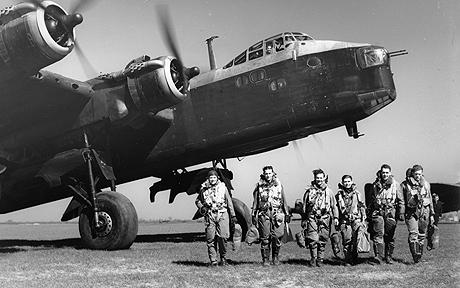The 75 Sqdn left from Mepal at 1943-07-25 at 22:04. Loc or duty Hamburg
He flew with a Short Stirling (type III, serial EE890, code AA-L).
Campaign report of the USAAF:
(Eighth Air Force): VIII Bomber Command Mission Number 76: Three locations in Germany are targetted; 19 heavy bombers are lost, mostly to effective formation attacks by German fighters. The raid on Hamburg is part of 6 Combined Bomber Offensive (CBO) missions against that port city and follows a raid of the previous night during which nearly 750 Royal Air Force (RAF) heavy bombers did tremendous damage to the target.
The three targets are: 1. 123 B-17's are dispatched against the diesel engine works at Hamburg but due to cloud cover, 100 hit the shipyard at 1630-1645 hours; they claim 38-6-27 Luftwaffe aircraft; 15 B-17's are lost and 67 damaged; casualties are 1 KIA, 5 WIA and 150 MIA. 2. 59 B-17's are dispatched against the Kiel Shipyard but return because of cloud cover. 3.
141 B-17's are dispatched against the aviation industry at Warnem- unde; 118 hit the Kiel Shipyard at 1630-1700 hours; they claim 6-0-0 Luftwaffe aircraft; 4 B-17's are lost, 1 is damaged beyond repair and 50 are damaged; casualties are 1 KIA, 3 WIA and 40 MIA. VIII Air Support Command Mission Number 3: 18 B-26B's are dispatched against the coke ovens at Ghent, Belgium; 13 hit the target at 1458 hours; 6 aircraft are damaged.
Campaign report of the RAF:
24/25 July 1943
791 aircraft - 347 Lancasters, 246 Halifaxes, 125 Stirlings, 73 Wellingtons involved in the first raid of the 'Battle of Hamburg'. 12 aircraft - 4 Halifaxes, 4 Lancasters, 3 Stirlings, 1 Wellington - lost, 1.5 per cent of the force. 'Window' was used for the first time on this night. Conditions over Hamburg were clear with only a gentle wind. The marking - a mixture of H2S and visual - was a little scattered but most of the target indicators fell near enough to the centre of Hamburg for a concentrated raid to develop quickly. 728 aircraft dropped the bombs bombs in 50 minutes. Bombing photographs showed that less than half of the force bombed within 3 miles of the centre of Hamburg and a creepback 6 miles long developed. But, because Hamburg was such a large city, severe damage was caused in the central and north-western districts, particularly in Altona, Eimsbüttel and Hoheluft. The Rathaus, the Nikolaikirche, the main police station, the main telephone exchange and the Hagenbeck Zoo (where 140 animals died) were among the well-known Hamburg landmarks to be hit. Approximately 1,500 people were killed. This was the greatest number of people killed so far in a raid outside the area in which Oboe could be used.
33 Lancasters of No 5 Group returning from North Africa bombed Leghorn docks but the target was covered by haze and bombing was scattered. No aircraft lost.
13 Mosquitos carried out diversionary and nuisance raids to Bremen, Kiel, Lübeck and Duisburg; 6 Wellingtons laid mines in the River Elbe while the Hamburg raid was in progress and there were 7 OTU sorties. No aircraft lost.
25/26 July 1943
Essen attacked by 705 aircraft - 294 Lancasters, 221 Halifaxes, 104 Stirlings, 67 Wellingtons, 19 Mosquitos. The commander of the American VIII Bomber Command, Brigadier-General Fred Anderson, observed this raid as a passenger in an 83 Squadron Lancaster. This was an attempt to achieve a good raid on this major target while the effects of 'Window' were still fresh. The raid was successful, with particular damage being recorded in Essen's industrial areas in the eastern half of the city. The Krupps works suffered what was probably its most damaging raid of the war. The next morning, Doktor Gustav Krupp had a stroke from which he never recovered; this saved him from being charged with war crimes after the war.26 aircraft - 10 Halifaxes, 7 Stirlings, 5 Lancasters, 4 Wellingtons - lost, 3.7 per cent of the force.
6 Mosquitos to Hamburg and 3 each to Cologne and Gelsenkirchen, 17 aircraft minelaying in the Frisians, 7 OTU sorties. No losses.
With thanks to the RAF and USAAF.net!
This record can also be found on the maps of Back to Normandy with Google coordinates. You can find the maps by clicking on this link on this location.
There are several possibilities to investigate the flight records on Back to Normandy. All the flights are plotted on maps, sorted "day by day", "by squadron", "by type aircraft", "by year or month", "by location" and much more! Don't miss this!!!
If you have any information that you want to share, please add your comment at the bottom of this record. Or send your information to [email protected]. This information will be added to the record.
Your photos and your information are very welcome! The young do care and with your help we keep up the good work.



